Palm trees come in various shapes and heights and can add stately architectural beauty to your home’s landscape thanks to their column-like trunks and rustling fronds. Selecting a palm tree that works for you starts with being able to identify one from the next. Sometimes, making an accurate palm tree identification can be challenging and confusing even to experienced gardeners. Here are the most popular fast growing palm trees to try.
- King Palm
- Carpentaria Palm
- Fishtail palm
- Windmill Palm
- Jucara Palm
- Majesty Palm
- California Fan Palm
- Foxtail Palm
- Queen Palm
- Mexican Fan Palm
- Chilean Wine Palm
- Acai Palm
- Royal Palm
- Bottle Palm
- Needle Palm
- Christmas Palm
- Lady Palm
- Cardboard Palm
- Bismarck Palm
- Triangle Palm
King Palm

King palms grow to a height of 40 to 60 feet with a canopy spread of 10 to 15 feet. Attractive pink to purple flowers form just under the tree’s canopy in midsummer, followed by half-inch berry-like fruit that start out green and then ripen to red. This palm grows quickly and requires very little care.The King Palm is a remarkably fast grower, growing 3 feet (1 meter) or more annually. This palm tree can live up to 150 years, which is a positive feature in city and urban areas that need less tree replacement and more consistent growth.
Carpentaria Palm

Carpentaria Palm has a smooth single trunk ringed with old leaf scars that are far apart because of the rapid growth. Slender gray trunk is about 10 inches in diameter, slightly swollen at the base and is topped with beautiful crown of gracefully arching fronds.The Carpentaria Palm produces beautiful green to white flowers all year around. Carpentaria is a fast growing palm that can get up to 20-30 ft tall and 5-10 ft wide. After 5-6 years Carpentaria Palm develops beautiful brilliant red fruits hangs in large clusters from the trunk.
Also Read: Different Types of Palm Trees For Landscaping
Fishtail Palm
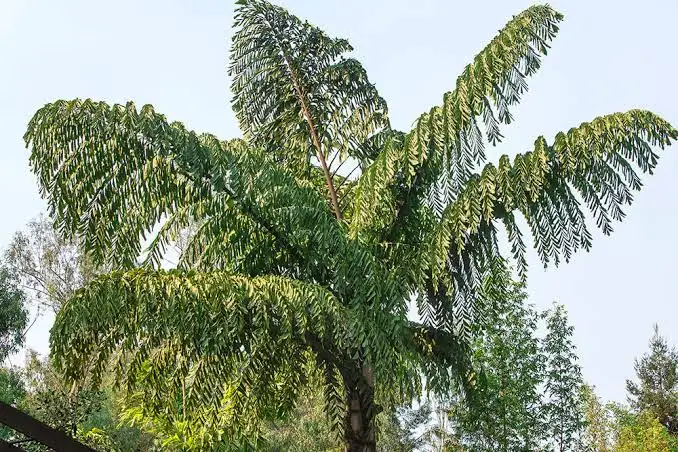
Fishtail palms grow to roughly 25 to 30 feet in height with an erect, silvery gray trunk and a crown of arching, segmented fronds. If planted in the right conditions, they grow quickly, about 12 to 24 inches (30 to 60 centimeters) per year, once established. The fronds resemble a fish’s tail, earning the tree its common name. A flower stalk emerges from the tip of the trunk once the tree matures and it blooms in stages over the course of several years. As the individual segments fade, a garland-like cluster of round, green fruit is formed. The fruit takes nearly nine months, or 40 weeks, to ripen, during which time it turns a dark reddish color.
Windmill Palm
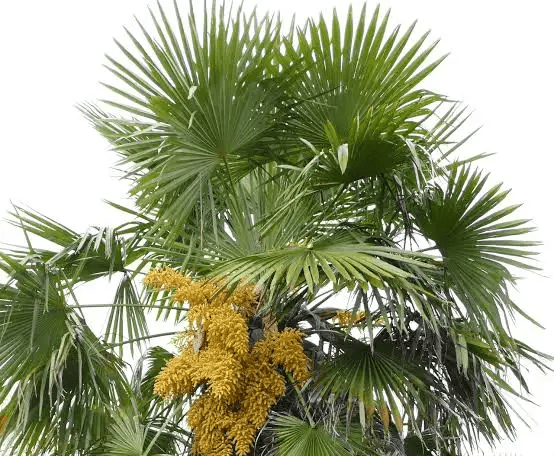
A slender palm with large, fan-shaped leaves, windmill palm is an attractive, mid-size palm. The trunk, covered with a fibrous, burlaplike material, is wider at the top than the bottom. Windmill palm grows indoors in bright light, but is usually planted outdoors when it matures because the plant reaches heights of 30 feet and widths of 10 feet. Long evergreen fronds spreading from 6 to 10 feet grow from a single trunk with a symmetrical crown. While both male and female palms produce 2- to 3-inch yellow or cream-colored flowers, only those on female trees produce blue fruit. Expect a windmill palm to grow 1 to 2 feet each year.
Jucara Palm
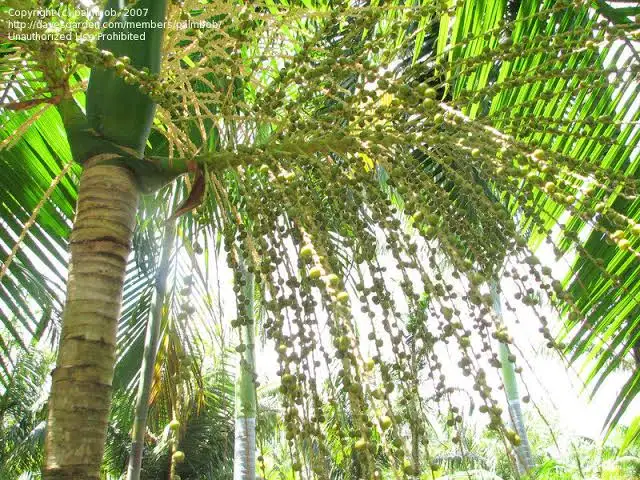
Jucara Palm or Euterpe edulis, otherwise known as jussara, acai-do-sul, or palmiteiro, is a tall, tropical palm tree primarily used for its palm heart. It grows usually about 10 m tall and 12 cm across. The trunk is light grey or brown in colour, and has prominent rings of leaf base scars. The leaves are dark green and have fine and feathery leaflets along the stalk. The fruits are small, round, and black to brown. Euterpe edulis is fast and easy growing to moderate height, is suitable for cool temperate as well as tropical climates, and will take light to moderate frosts without damage. It also makes an excellent indoor palm, tolerating low light well.
Also Read: Different Types of Florida Palm Trees
Majesty Palm

The Majesty palm, also called majestic palm is native to Madagascar and grows to about 40 feet tall, showcasing a smooth, flared trunk topped with a canopy of large, rich-green, feathery leaves. The tree also features a large, untidy crown and a smooth trunk that is about 12 inches in diameter at maturity. It produces small, white flowers that develop into bright red, spherical fruits that are about 1/2 inch in diameter. Majesty palm has a moderate to fast growth rate, and may grow only a foot or so per year.
California Fan Palm

California Fan Palm is a medium to large evergreen palm with a tree-like growth habit. It has a sturdy columnar trunk crowned by beautifully shaped, fan-like, waxy gray-green blades, that spread and arch from stout, spiny petioles. Unlike other palms, the dead leaves fold down against the trunk rather than dropping off. This palm tree is sometimes called “Petticoat Palm” in reference to the shaggy mass of dead leaves hanging against the trunk and forming a dense skirt. In summer, creamy-white, tubular flowers are produced in huge sprays. They are followed by great quantities of black, pea-sized fruits. The California Fan Palm grows to heights of 49-66 feet (15-20 meters). These palms can potentially grow up to a foot and a half per year but are more likely to grow about half of that height in normal gardening conditions.
Foxtail Palm

The foxtail palm is a tall tropical tree with full foliage. Typically standing 25 to 40 feet high, the top of the tree explodes into a cluster of 8 to 10 green fronds. It usually grows more than a foot a year and can reach its full height in 20 years or less. Setting itself apart from other tropical palm trees, the foxtail palm features hundreds of leaflets that twist from the stem in all different directions, creating the fox-tail appearance that inspired its common name. The trunk is narrow and slender with brown and gray coloring. The tree blossoms with white flowers that develop into small red fruits.
Also Read: How To Grow And Care For Ponytail Palm
Queen Palm

Prized for their feathery fronds and relatively fast growth rate, queen palms can reach 65 feet tall and are known for their love of sunshine and high drought tolerance. Plumes of creamy white flowers are produced in the summer, and trailing clusters of orange fruit appear at the beginning of winter. This palm has the standard palm tree shape, featuring graceful arching fronds at the top of the trunk.The feathery, glossy green fronds are pinnately compound, each up to 15 feet long. The fronds may turn yellow or brown as they age and die. Queen palms have a growth rate of approximately 2 feet per year.
Mexican Fan Palm

Washingtonia robusta, commonly called the Mexican fan palm or Washington palm, grows 50 to 60 feet tall or more with a single trunk and a canopy spread of 10 to 15 feet.The fan-shaped leaves of Mexican fan palm can be 5 feet long and 3 to 4 feet wide, with sharp spines along the bases of the leaf stems. The leaves droop down as they die, laying flat against the trunk. The trunk is narrow, 10 to 12 inches in diameter, with rings of old leaf scars close together along the trunk, forming a somewhat smooth surface. Flowers of Mexican fan palm are white and showy, appearing on long stalks in summer. They are followed in fall by oval to round 1/2-inch-long fleshy black fruits. The Mexican Fan Palm grows up to 3 feet a year once established. Small specimens can be planted in containers and used to accent patios or entryways.
Chilean Wine Palm
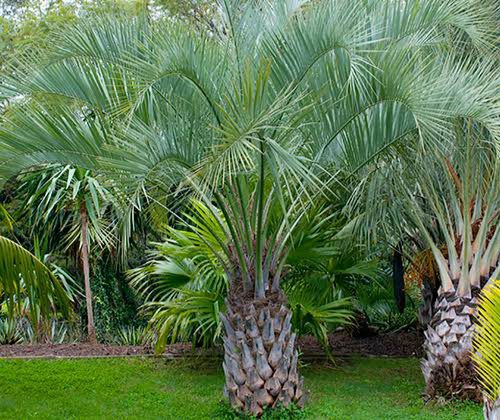
Prized as one of the most impressive palms in the world, Chilean Wine Palm is a fast-growing evergreen palm with a huge and massive gray trunk supporting a dense crown of gracefully arching featherlike leaves. Each pinnate gray-green leaf is up to 15 feet long and divided into many narrow, rigid leaflets. The thick columnar trunk is the biggest of any palms. It is often swollen above its base. Chilean Wine Palm is a monoecious species, meaning that one tree has both male and female flowers. Sprays of small, bowl-shaped, purple and yellow flowers are produced in summer on mature trees (50 years old). The flowers give way to large clusters of rounded, edible, yellow fruits, with a soft pulp that tastes like coconut.
Also Read: How To Grow And Care For Ruffled Fan Palm
Acai Palm

The plant has long been valued commercially for its high-quality hearts of palm, and its fruits, touted as a superfood, grew in popularity worldwide in the early 21st century. Acai palms consist of 4–8 slender gray-brown stems, each of which is about 82 feet tall and generally no greater than 20 cm in diameter. The stems bear ringlike leaf scars and are topped with a crown of compound leaves; The small brown-purple flowers are either staminate (male) or pistillate (female) and are borne on large branching inflorescences that hang from the tops of the stems. Individuals of açaí are commonly found in high densities spread over swamps and floodplains in clumps that can have up to 20 stems. There are two main varieties of açaí palm: the purple or black, and the green or white açaí, where the difference is in the fruit’s skin (epicarp) color of ripe fruits.
Royal Palm

The fast-growing royal palm tree features a long, smooth trunk that tapers as it reaches upward. They grow 1-2 feet per year. Mature palm attain heights of about 50 to 100 feet, with canopies that spread up to 25 feet. These trees sport 8-inch long leaflets on 10-foot lengths of glossy pinnate leaves. The royal palm trees produce inflorescences with creamy white or creamy yellow flowers. Indoor plants don’t flower. The inflorescences appear in the middle of the summer and measure about three to four inches thick and 10” inches long.
Bottle Palm

Bottle palms are moderately fast-growing and attractive palm trees with stout, bottle-shaped trunks and feathery leaves. Although the tree reaches heights of only 10 to 12 feet, the dramatic, arching leaves extend to lengths of up to 10 feet. As the palm ages, the swollen base becomes less pronounced and elongated. On top of the trunk sits a sparse canopy of 4-8 gracefully arching, glossy dark green, feather-like leaves. The crownshaft (from which the fronds emerge) is a paler green, with a smooth and waxy surface. Each leaf is divided into 140 slender, lance-shaped leaflets arranged in two upward pointing rows. Creamy-white flowers borne in branched inflorescences encircle the trunk beneath the crown.
Also Read: Different Types of Japanese Maple Trees
Needle Palm

Needle Palm is a shrubby, rounded, evergreen palm with a short, thick trunk and large, palmate, lustrous dark green leaves that can reach 3 feet in diameter (90 cm). Borne at the tips of unarmed petioles, each leaf is deeply divided into 5-12 stiff and narrow segments, arranged in an open fan. Creamy-white flowers are held in densely branched panicles and are usually hidden by the foliage. They give way to small, reddish brown fruits. The leaf sheaths have long, needle-like, stiff and sharp spines (hence the common name), making this dense-foliaged palm impenetrable to most wildlife. Needle Palm is a moderated fast growing palm, but with appropriate care and fertilizing it grows faster.
Christmas Palm
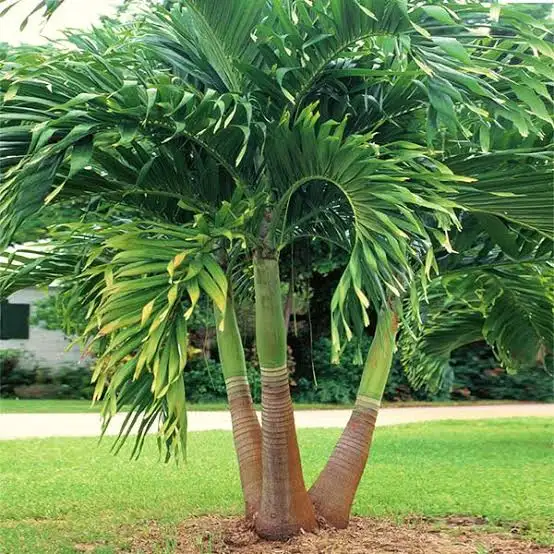
The common name, “Christmas palm,” comes from the clusters of bright red fruits that adorn these trees in late fall and winter, giving the plants the appearance of being decorated for the holidays. The Christmas palm is a terrific choice that will not overwhelm a landscape in size or workload (unless you want to contend with the fruit) because it grows quickly to 5 or 6 feet and levels off to a slower growth that reaches its final mature height of 25 feet. Plant it any time during the year when there’s no threat of cool weather. Growing Christmas palm trees in the home landscape is a perfect way to get that tropical feel without the hassle of the bigger specimens of palm.
Cardboard Palm

Cardboard palms grow pinnate leaves (a leaf composed of many small leaflets on either side of a stem) much like a palm frond that you’d find on a lipstick palm. The leaflets are bright green and oval, and they have a slightly fuzzy feel similar to cardboard. The plant is generally shorter than it is wide, with a thick, partially subterranean trunk. It has a moderately fast growth rate and is best planted in the spring.
Lady Palm
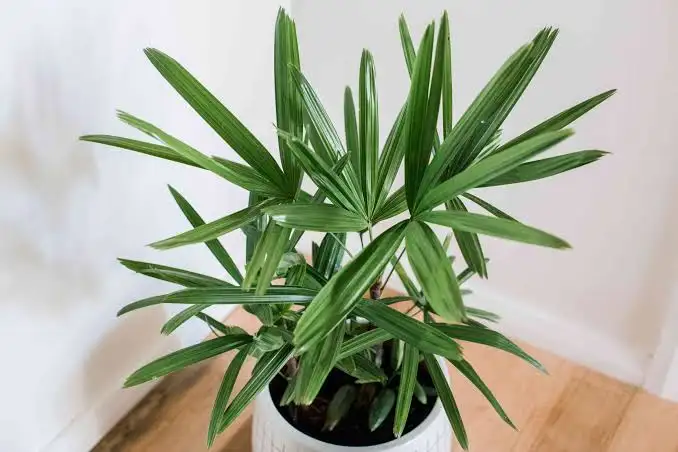
The lady palm is called a fan palm because it has thin, individual stalks originating from its base that end in fan-shaped leaves. Its stalks are similar to bamboo, with prominent nodes and dark rings at each node. The lower part of each stalk is covered in a coarse, loose, brown-colored fiber, adding to the plant’s interesting appearance, while its leaves are extremely dark green and quite shiny. As a lady palm matures, it forms an expanding, dense clump of stalks and leaves. A moderately fast-growing plant, the lady palm can grow up to 10 feet tall when grown outdoors under ideal conditions.
Bismarck Palm
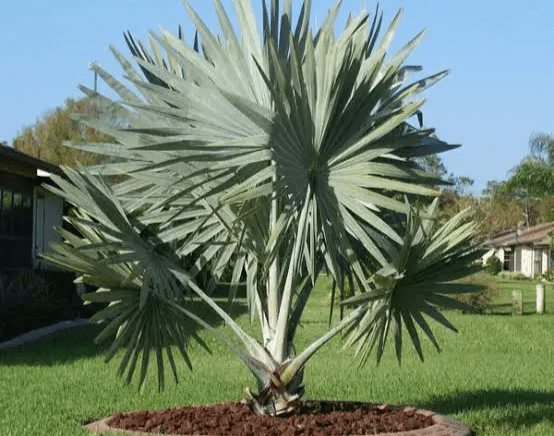
Loved for its striking foliage color and texture, Bismarck Palm is an evergreen palm adorned with a thick trunk topped by a broad rounded head of gorgeous, stiff, intensely steel-blue, fan-shaped fronds. The persistent leaf bases are split, creating an attractive pattern on the trunk. Bismarck Palm grows rather slowly when young but once it develops a trunk, growth rate is more moderate. The bold texture and color and eventual great height of this species make a strong and dramatic statement in any landscape.
Triangle Palm

Triangle Palm is a small to medium sized palm adorned with a solitary trunk topped with a three-ranked crown of gray-green to blue-green, keeled, feather leaves. The common name of this palm comes from the triangular shape that is formed by three distinct points where the fronds emerge. The leaves, up to 10 get are held well above the horizontal and arch near their tips. The dark gray trunk, 12-20 inches thick is stocky and smooth with obvious leaf scars. In the spring, small pale yellow flowers are borne in large branched inflorescences, that emerge near the base of the lower leaves. They give way to round, green, marble-size fruits that mature to creamy-white.